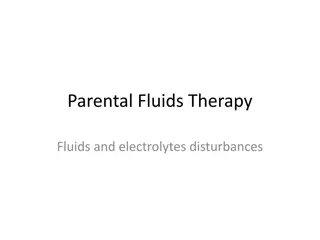Understanding Fluid Therapy in Veterinary Medicine
In the nineteenth century, fluid therapy was limited to severely ill patients, but now both veterinary and human medicine utilize intravenous fluid therapy extensively. Dehydration can have serious consequences, and isotonic replacement fluids are essential based on estimated dehydration, maintenance needs, and ongoing losses. Proper fluid management is crucial for perioperative patients and those with evidence of dehydration in animals. Various physical examination findings help in assessing dehydration levels, with different formulas used depending on the severity of dehydration.
Download Presentation

Please find below an Image/Link to download the presentation.
The content on the website is provided AS IS for your information and personal use only. It may not be sold, licensed, or shared on other websites without obtaining consent from the author. Download presentation by click this link. If you encounter any issues during the download, it is possible that the publisher has removed the file from their server.
E N D
Presentation Transcript
Fluid Therapy Lec. Dr. Rafid M. Naeem,
In the nineteenth century. Only severely ill patients received intravenous fluids and proctoclysis (rectal administration of fluid), while less critical patients were given subcutaneous and intraperitoneal fluid therapy . In both veterinary and human intravenous fluid therapy are remarkable
Perioperative patients often are not drinking or eating. The animal continues to make urine, saliva, and gastrointestinal secretions, and lose fluid via respiratory evaporation. During times of illness or following surgery, both increased fluid losses and decreased intake may lead to dehydration. .
Dehydration, also known as hypohydration, is defined as loss of bodily fluids and can cause changes in all fluid departments, depending on the type of fluid lost. Abnormal fluid losses commonly occur via urinary (e.g., polyuria) and gastrointestinal (e.g., diarrhea and vomiting) losses, although skin (e.g., burns) ec.
Isotonic replacement fluids should be administered according to a. the patient s estimated dehydration (replacement need), b. maintenance needs, and c. anticipated ongoing losses.
Physical examination findings in animals with evidence of dehydration can be found in this Table
in animals with 5% to 8% dehydration) use the following formula: Ongoing losses include those caused by vomiting, diarrhea, polyuria, open wounds or burns, fever, third- spacing, or blood loss.
Maintenance fluid rates are estimated at 2 to 4 mL/kg/hr, with larger or overweight animals using the lower end of the range and smaller or thin patients the upper end. More exact requirements can be found in Tables
During anesthesia, most animals are given 5 to 10 mL/kg/ hr of isotonic crystalloids intravenously to maintain intravascular volume and pressures. Animals that have considerable ongoing losses and those that will not be able to drink within a short time require additional fluid therapy. Continued intravenous fluid therapy is especially important in geriatric animals, those that have considerable postoperative fluid losses and patients that are not cardiovascularly stable.
FLUID TYPES AND USES The common Fluid types available for use in the surgical patient include isotonic crystalloids, hypotonic crystalloids, hypertonic crystalloids Crystalloid solutions contain electrolytes and other solutes 1. Isotonic crystalloids, also known as replacement fluids, are electrolyte-containing fluids with a composition similar to that of extracellular fluid.
1. Isotonic Crystalloids Isotonic crystalloids are the type of fluid most commonly used for perioperative treatment. Infusion of isotonic crystalloid fluids does not significantly change the osmolarity of the vascular or extravascular (both interstitial and intracellular) space. These fluids are typically used to expand the intravascular and interstitial spaces and to maintain hydration.
Isotonic crystalloids most commonly used contain mixtures of electrolytes, water, acid- base components, dextrose. Most available isotonic crystalloids, other than 0.9% NaCl, contain a bicarbonate precursor such as lactate, acetate, or gluconate. These fluids are extracellular-expanding fluids, and 75% of the volume infused redistributes to the interstitial space, while only 25% remains in the vascular space . " . A typical shock dose is 1 blood volume (i.e., 90 mL/kg in the dog and 50 mL/kg in the cat)., . 1 ( 90 / " 75 25 / 50
Excessive fluid administration should be avoided and can be harmful to the small animal surgical patient. Interstitial fluid gain can lead to interstitial edema, pulmonary edema, and cerebral edema. Animals with recently lacerated or ruptured blood vessels are susceptible to rebleeding following aggressive fluid therapy. In those animals suffering blood loss, hypotension may contribute to cessation of bleeding. .
Surgical patients with a hypochloremic metabolic alkalosis will benefit from 0.9% NaCl because this is the highest chloride- containing fluid .It will help to normalize blood pH by dilution and by increased chloride, with a subsequent decrease in bicarbonate concentration. . Surgical animals that are severely acidotic may benefit from a crystalloid that contains a buffer agent such as acetate, gluconate, or lactate (i.e., NOT 0.9% NaCl because this fluid tends to be acidifying). 0.9 ( .) Large quantities of acetate can cause vasodilation and a decrease in blood pressure in animals with preexisting hypovolemia. .
2. Hypotonic Solutions Maintenance fluids are hypotonic and refer to the volume of fluid and quantity of electrolytes that must be consumed on a daily basis to keep the volume of total body water and electrolyte content within the normal range. . They are especially useful in perioperative patients that are not eating or drinking but are otherwise stable and do not have ongoing fluid losses beyond those of a normal animal. Maintenance solutions include 0.45% sodium chloride, 2.5% dextrose with 0.45% saline, 2.5% dextrose with half-strength lactated Ringer s solution Large volumes of hypotonic maintenance fluid administration can lead to a rapid decrease in osmolarity and subsequent cerebral edema.
3. Hypertonic Solutions Hypertonic (7.0% to 7.5%) sodium chloride administration causes a transient osmotic shift of water from the extravascular to the intravascular compartment. Small volumes of 4 to 6 mL/kg can be administered over 10 to 20 minutes. ( 7.0 7.5 ) . 6 / 10 20 . Hypertonic saline is especially useful for the treatment of a. head trauma or b. cardiovascular shock in animals >30 kg that require large amounts of fluid for resuscitation e.g., patients with gastric dilatation-volvulus. 4
Because of the osmotic diuresis and rapid redistribution of sodium cations that ensue following administration of hypertonic saline, the intravascular volume expansion is transient (<30 minutes) therefore additional fluid therapy must be used to maintain intravascular volume and prevent dehydration. ( 30 ) 25% mannitol could also be used as a hypertonic fluid.























